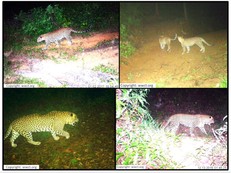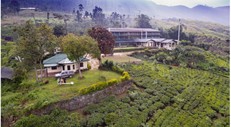- 6 July 2017
Leopard and Biodiversity Research and Conservation in Norwood area
Leopard and Biodiversity Research and Conservation in the Norwood, Castlereigh and Bogawanthalawa Valley areas bordering Peak Wilderness Sanctuary Dunkeld Conservation Station, June 2017.
Leopard and Biodiversity Research and Conservation in the Norwood, Castlereigh and Bogawanthalawa Valley areas bordering Peak Wilderness Sanctuary Dunkeld Conservation Station, June 2017.
Continued research being carried out by The Wilderness & Wildlife Conservation Trust (WWCT) within the surrounding area that borders the Peak Wilderness Sanctuary is revealing some remarkable results. The Dunkeld Conservation Research Station has acted as a base from which a dynamic WWCT team has been conducting a variety of important studies. Both long and short term monitoring with a focus on the endangered Sri Lankan leopard has been implemented in the surrounding tea estate areas with remote cameras placed at 45 different locations within the past 11 months. This is the first ever study to look at leopard/wildlife movement in this unprotected mixed landscape of tea/plantation and forest lands within the Central Highlands of Sri Lanka.
Some Research Results
Having completed 2 rounds of remote camera surveys in the central Castlereigh region with a high success rate, survey rounds 3 and 4 are now ongoing along the eastern end of the Bogawanthalawa Valley. Long term monitoring around the Dunkeld Conservation Station is continuing with results revealing the social make up and range use of the leopards residing in the vicinity of the DunkeldNorwood estate area.
The short term remote camera surveys allow us to estimate leopard population numbers, prey availability/biodiversity and also to track individual leopard movement, activity patterns and to some extent map their territorial ranges. Ideally radio collars is what is needed for in-depth movement monitoring and supported by Dilmah Conservation and Oxford University’s WildCru we have obtained collars, however are awaiting Wildlife Department approval for deployment of these collars on appropriate leopards.
So far 27 individual leopards as well as 22 species of other mammals have been identified. Expanding from the original 20 locations in the west, monitoring cameras are now set up in the east in order to assess leopard movement and population between the two areas.
Long Term Monitoring within the Dunkeld-Norwood Tea Trails Complex
The long term monitoring established within the complex of Dunkeld, Norwood, Kelani-Breamer and Castlereigh (Osborne) estates, which form the core of the research area, allows for a more in-depth understanding of the leopards living in these particular estates. We know now that two females, most likely a mother and daughter, share this range. They both have cubs at the moment; an older male cub and a younger set of cubs that we are still to capture on the remote cameras but we know are here as the mother is visibly nursing. An additional female also uses portions of this area. This long term monitoring has also revealed that ‘Arnold’ our well established male leopard in this area continues to use this complex as his core range, moving through these estates every few weeks. In addition we are documenting another male regularly, as well as a visiting male from the western Peak Wilderness area making for a current population of at least 6+ individuals who call this complex home.
Leopards of Dunkeld/Norwood area:
- Resident adult female KB in the Dunkeld area who currently has young cubs.
- Resident adult female (possibly KBs daughter) with her 1+ year old male cub.
- Resident male Arnold who continues to frequent the Norwood end of the Dunkeld-Norwood area.
- Resident adult male OC frequenting the Dunkeld area.
Long term monitoring has also been used for the identification of a leopard prey base and to provide insight into the consumption of domestic animals. One important reason why the project was originally proposed to Resplendent Ceylon/Dilmah Conservation was to establish the reasons for deaths of leopards within the tea estates. Since starting the research project, the Wilderness and Wildlife Conservation Trust has found that leopards are using temporal niche partitioning, meaning that they are moving at night when there are no humans present on the same landscape, thereby themselves actively avoiding human presence. This suggests that they are adapting to the threat of conflict by avoiding humans all together for the most part, and that incidents have only occurred during early hours of the morning when there is some overlap between leopard and human activity. This fascinating discovery is the key to their survival in this highly fragmented area and has we feel what has allowed for such low levels of conflict overall. However in order to maintain this coexistence, temporal niche partitioning must be tolerated by local communities. WWCT is now able to give this important Information to the tea plantation communities and plantation managers and our awareness work focuses on this and the importance of these watershed forests. Setting of snares for capture of other wildlife such as wild boar and dear are also resulting in leopard deaths and during the course of our research we have been removing such snares that we encounter; this action needs to be dealt with by the tea estates as well, so as to reduce these incidents of leopard mortality in the region. Seeing that hunting of wildlife is illegal we feel that this is something that needs to be addressed more specifically.
New proposed Ridge Protection
The most significant result of the ongoing work by WWCT based out of the Dunkeld Conservation and Research Station is the identification of the important role the ridge between the Castlereigh and Maskeliya reservoirs holds for leopard conservation in this area (figure 1). This ridge backs onto the Dilmah Dunkeld tea gardens as well and is where we are documenting female leopards residing. The females were confirmed to be residing in this area rather than passing through it and most importantly, they were shown to be breeding here. This residency is very different to the roaming patterns of males who occupy very large areas. The WWCT therefore confirm that this ridge is a vital area for leopard breeding and residency and protection of it is extremely important.
This ridge forms a connector corridor between the north-west and south east sections of peak wilderness and rings the teas estates here, creating a forested movement corridor for leopard and other wildlife between the two areas of Peak Wilderness Sanctuary (see image above). This is key for continued persistence of this highland leopard population. Several other endangered species are also present within this ridge forest area, including the purple faced langur and three critically endangered shrew species.
Following the identification of this important ridge area, a proposal was presented to the Chamber of Commerce Plantation Sector via the Biodiversity Sri Lanka platform. Members seemed very keen to move forward to get partners on board for supporting the project and working in partnership with Biodiversity Sri Lanka we hope to see this proposal into reality. This important work is made possible due to the establishment of the Dunkeld Conservation Station which has allowed for WWCTs ongoing work here. Continued monitoring is essential and we hope that this novel research and conservation drive will continue in this section of Sri Lanka’s Central Highlands World Heritage Site.
Dunkeld Conservation Station-home to the WWCT team- in the foreground with the Dilmah tea factory to the right and the ridge-home to leopards- in the background.
The WWCT team
June 28, 2017
The Wilderness & Wildlife Conservation Trust
The Leopard Project
130 Reid Avenue, Colombo 04, Sri Lanka
Tel: +94 11 2589468/+94 773 544 382
Email: info@wwct.org
Website: www.wwct.org

Extended Stay Savings
Extend your stay for 6+ nights at Cape Weligama, save more and enjoy the holiday of a lifetime.




















